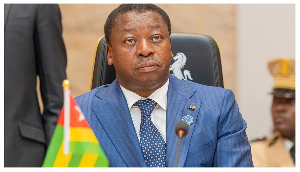- Home - Entertainment
- Lifestyle News
- Entertainment Videos | TV
- Year In Review
- Music News
- Entertainers
- Entertainment Archive
- Entertainment Photos
- Jokes
- Entertainment Headlines
- Ameyaw Debrah
- Brown GH
- Celebrities Buzz
- GH Base
- Ghana Celebrities
- Gh Gossip
- GH Page
- GH Splash
- Hot Gossip GH
- YEN

Tabloid News of Monday, 7 January 2002
Source: The Spectator
Serial killer to appear in court
At the tender age of 18, precisely on August 17, 1986, he had his first brush with the law when he was cited in a Dansoman rape case.
He ran away but was arrested two days later and charged with the offence. He faced trial at the Accra Circuit Court B and was sentenced to nine months in hard labour.
Three months after his release from prison, he committed a similar offence and added a new dimension to it by robbing the victim as well. Incidentally, this also happened at Dansoman, and he was convicted and served three years at Nsawam Prisons.
While serving the sentence the young man met another prisoner by name John Bita, whom he served in prison.
Realizing his friend’s intelligence, meekness and willingness to learn, Bita taught him carpentry and helped him to find a job at Logs and Lumber Company in Kumasi, after his release. It was there that his history of serial killings began.
He raped and killed a number of women, especially in the vicinity of the Kwame Nkrumah University of Science and Technology. Most of his victims’ bodies were rotten before they were found.
The man later left Kumasi for Dansoman, Accra, in 1989, and not too long after, the Accra serial murders began in earnest.
This is the man whose trial will begin in Accra on January 28, 2002 to answer for his self confessed crimes. He is Charles Ebo Quansah who comes from Komenda in the Central Region.
Charles Ebo Quansah, the suspect self-confessed serial killer, who claims to have murdered eight women in the serial killings saga, will be arraigned before court on January 28, 2002. On that day, a capacity crowd is expected to witness what has been described as the trial of the decade.
And for the first time, the public will have the opportunity to catch a glimpse of the man who has reportedly taken the lives of eight women. Charged with murder as directed by the office of the Attorney-General, Quansah also known as Paapa Kwabena Ebo has since his arrest, remained in prison custody. He was arrested in May last year.
In an interview with “The Spectator,” Mr David Asante-Apeatu, Head of Operations, Criminal Investigations Department (CID) of the Ghana Police Service described Quansah as dangerous.”
His record with the police shows that Quansah has served two different rape sentences at James Fort and Nsawam Prisons respectively even before his involvement in the serial killings.
Mr Apeatu stated that Quansah is very normal and there is proof of him working with very knowledgeable people until his arrest. He debunked the notion by some people that he was insane.
Obviously, police investigations into the case provide vital information that will help women to avoid falling prey to serial killers in the future. “The Police would educate the public on the investigations carried out so far on the series of events that led to the arrest of Quansah and how he carried out his killings”, Mr Apeatu said.
But according to Mr Asante-Apeatu, this would not take place until after the trail. “Although Quansah has not mentioned any accomplices, the police do not doubt the involvement of other suspects.”
But from Mr Apeatu, experience has taught him that serial killings could be the handiwork of a single person. Quansah, a 36-year-old man, a driver mechanic, mason and a carpenter has reportedly, confessed to killing eight of the women in the mysterious serial killings that have rocked Accra and Kumasi since 1993. So far, his victims are not yet known by the public. But these may emerge when the trial fully begins.
The murders occurred mainly at Dansoman, Adenta and Mataheko, all suburbs of Accra and in Kumasi. Before Quansah’s arrest, Ghanaians were worried as the police were virtually, at their wits end as to who was behind the killings.
It became obvious that the police alone could not solve the problem single-handedly without public cooperation and support. The killing of women for ritual purposes were reported once in a while, but the serial nature of these murders was a real enigma that needed to be unraveled.
On December 17, 1998, residents of Mataheko sparked off a mob action in their area against resident aliens alleged to be behind the killings. Madam Adwoa Kyeraa, 45, had been found dead that morning at a hotel suspected to be occupied by aliens only a few days after a similar death had occurred in that area.
The nature of the killing was similar to what pertained in the case of 16 earlier deaths, which had occurred within the same vicinity since March that year. The Police, denied the allegation of the murder, claiming that Madam Kyeraa had died from hypertension as indicated by a pathologist’s report.
In any case, people were arrested in connection with the death and the Attorney General’s office was reported to be handling the dockets.
The killings did not stop as Ghanaians witnessed the death of yet another woman. And the police persisted in their denial that the murders were the work of serial killers. This outraged the public who felt the police were just covering up their inability to track down the perpetrators.
The public outcry intensified as news of the murder of yet another woman got to Ghanaians. People took to the streets to demonstrate their outrage and disgust. Individuals were lynched at the least suspicion of their involvement in connection with the murders. A restaurant belonging to a foreigner was set ablaze as it was believed to be connected with the killings.
At an point in time, women irrespective of their political, social or economic background came together, took to the streets and demanded the end to the murders or in default a resignation by the then Inspector General of Police (IGP), Mr Peter Nanfuri.
A number of non-governmental organizations in the country also protested against the gruesome murders. The oganisations included the Federation of Women Lawyers (FIDA), Amnesty International, Ghana section, Ghana Employers Association, Business and Professional Women, The Ark Foundation and Network of Women’s Human Rights Organisation (NETRIGHT).
They felt the government was not doing enough to protect the women, and called on the government, the security agencies and parliamentarians to consider the serial killings as a national crises and deploy all available forces to take effective measures to apprehend the culprits.
The situation became more precarious as the perpetrators spread their tentacles to other suburbs of the city. Every woman was now at risk and fear reigned.
Results of post mortem examinations carried out on the victims indicated that most of them died of similar causes: Strangulation, Carbonate poisoning, Septicaemia and Severe Pulmonary Congestion. The then Parliament was compelled to hold a debate on how to deal with the problem.
A Ghana-based African Commission on Health and Human Rights Promoters (CAPSDH) appealed to its human rights counterpart organization throughout the world to help arrest the situation.
Also worried about the problem, the Methodist Church pledged an amount of ?5 million as a reward for anyone who would volunteer information that would lead to the arrest of the serial killers.
Moreover, the then Attorney General and Minister of Justice, Dr Obed Asamoah, gave the public the assurance that a solution to the problem was in the pipeline. But it never came and President Kufuor’s administration inherited the problem. It was one of the questions that was very dear to his heart just as he assumed office, promising the nation that they would do all they could to arrest the situation.
Consequently, the new government solicited the assistance of the American Federal Bureau of Investigations (FBI) to find a quick solution to the problem. However, in the midst of all these efforts, the perpetrators still operated until Quansah was finally arrested. His arrest, detention and confession ended the saga of deaths, mourning and burials in the capital city. And it confirmed one thing, that indeed the deaths were the handiwork of serial killers but who the accomplices of Quansah are is yet to be known. Here too, his trial may throw some light.
Madam Adwoa Kyeraa marked the first of the thirty-two or more deaths of women recorded as victims of the serial killings within the period. However, another murder of a woman occurred after Quansah’s arrest but under different circumstances. The body of the unidentified woman was wrapped in a sack and was discovered in the Densu River.
The question that is being asked is this: Was Quansah alone in this, or was he operating with an accomplice or accomplices? Indeed, this is the multi-million dollar question, to which Ghanaians are eagerly awaiting an answer.










